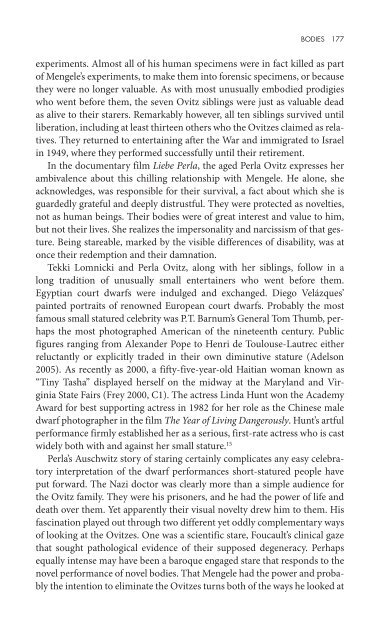Staring how we look sobre la mirada.pdf - artecolonial
Staring how we look sobre la mirada.pdf - artecolonial
Staring how we look sobre la mirada.pdf - artecolonial
You also want an ePaper? Increase the reach of your titles
YUMPU automatically turns print PDFs into web optimized ePapers that Google loves.
84 STARERS AND STAREES<br />
our staring from a breach of etiquette or an offensive intrusion into an act<br />
of appreciation. These portraits enable visual pilgrimages of deliberate contemp<strong>la</strong>tion<br />
that might be scuttled in a face-to-face encounter on the street.<br />
The invitation to <strong>look</strong> that a portrait offers precludes our skittish staring and<br />
instead allows us to <strong>look</strong> deep and long into these unfamiliar faces made<br />
strangely familiar.<br />
STARING BACK<br />
<strong>Staring</strong> is a high-stakes social interaction for everybody involved. The struggle<br />
for starers is whether to <strong>look</strong> or <strong>look</strong> away. The struggle for starees is <strong>how</strong><br />
to <strong>look</strong> back. Stareable people have a good deal of work to do to assert their<br />
own dignity or avoid an uncomfortable scene. People with unusual <strong>look</strong>s<br />
come to understand this and develop re<strong>la</strong>tional strategies to ameliorate the<br />
damage staring can inflict. Rather than passively wilting under intrusive and<br />
discomforting stares, a staree can take charge of a staring situation, using<br />
charm, friendliness, humor, formidability, or perspicacity to reduce interpersonal<br />
tension and enact a positive self-representation.<br />
In her memoir, Autobiography of a Face (1984), Lucy Grealy writes about<br />
discovering as a young girl the possibilities that staring back might hold<br />
for her. Grealy spent a lifetime as a staree after her multiple surgeries for<br />
jaw cancer, starting when she was eight years old. Having to navigate the<br />
world outside her family soon s<strong>how</strong>ed Grealy that she “possessed a certain<br />
po<strong>we</strong>r” because people “noticed” her. “Wherever I <strong>we</strong>nt, even just to the<br />
store with my mother, I was never over<strong>look</strong>ed,” writes Grealy, “I could count<br />
on some sort of attention, and I discovered that people <strong>we</strong>re embarrassed<br />
when I caught them <strong>look</strong>ing at me. I stared right back at the strangers. . . .<br />
They always <strong>look</strong>ed away quickly, trying to pretend they hadn’t been staring”<br />
(Grealy 1984, 101). What practiced starees come to understand, Grealy suggests,<br />
is that stares are to be engaged rather than avoided. Some take up this<br />
engagement with the relish and others with dread. Nevertheless, whether<br />
they are a challenge or a burden, stares do not necessarily make one a victim;<br />
rather, they can make one a master of social interaction.<br />
Accounts from starees such as Lucy Grealy about staring back find support<br />
in the portraits of people with disabilities by Doug Auld and Chris<br />
Rush. These portraits s<strong>how</strong> rather than tell <strong>how</strong> starees stare back. Portraits<br />
can provide their subjects with an opportunity to deliberately engage their<br />
vie<strong>we</strong>rs through the conventional poses of traditional portraiture. Eye comportment<br />
is one of the most important elements through which portraits<br />
define their subjects. Intense eye-to-eye engagement with the vie<strong>we</strong>r can


